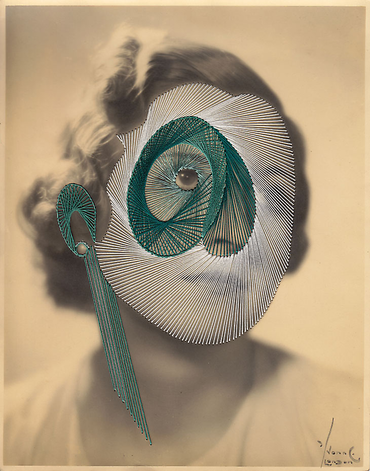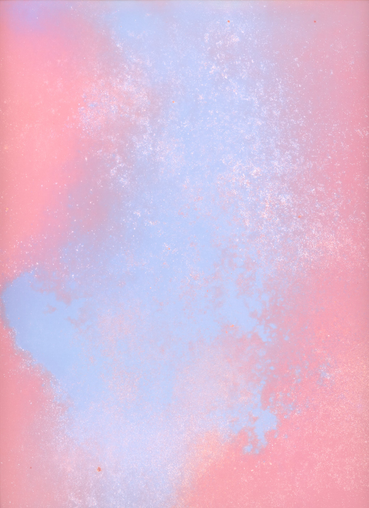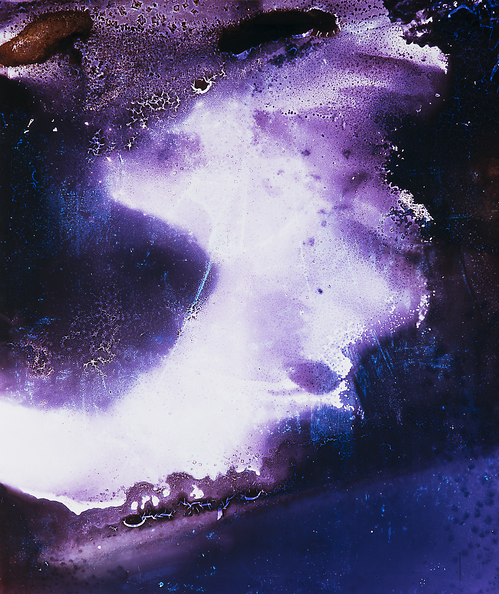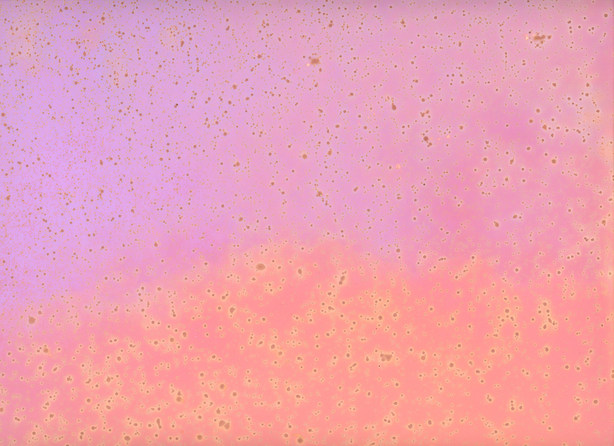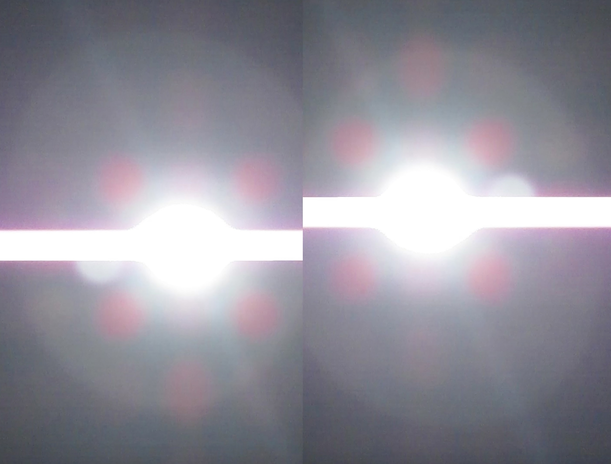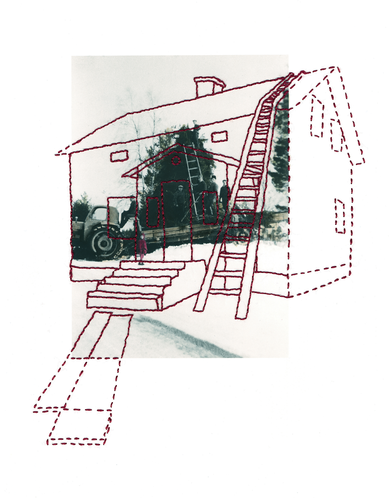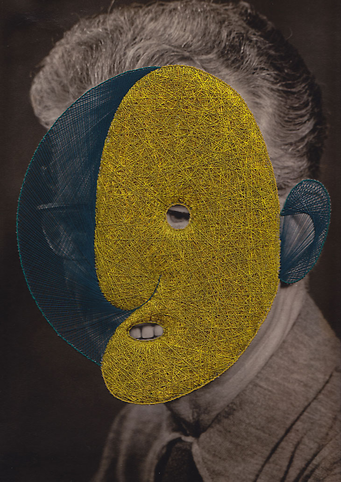Rebecca Najdowski & Jane Vuorinen
Surface Tension: Material Intra-Actions within Photography
1. Introduction
How does photography materially intra-act with other material phenomena and how do these interruptions, entanglements or comings-together reveal new qualities of photographic materiality itself? In this exposition, we use the concept of intra-action to think through and problematize photographic practices by looking at two cases: ‘photo-embroideries’ and ‘landscape photography’. Through these perspectives we propose a new materialist approach to thinking about photography, one that considers and appreciates photographic materiality.
Physicist and philosopher Karen Barad has expanded aspects of Niels Bohr’s philosophy-physics to be applicable beyond the hard sciences into the realms of the humanities and social sciences. Her concepts of agential realism and intra-action are particularly useful as a way of understanding knowledge practices such as photography. Broadly, agential realism is a framework that contends that matter is an “entanglement of relations”, and takes into account the agencies of the non-human (amongst other features).[1] As an aspect of agential realism, intra-action reworks how causality might be conceived in that “distinct agencies do not precede, but rather emerge through, their intra-action”.[2] That is to say that Barad’s ontology is based on relationality, and in her own words: “Matter’s dynamism is generative not merely in the sense of bringing new things into the world but in the sense of bringing forth new worlds, of engaging in an ongoing reconfiguring of the world.”[3] With this conception of matter, we expose how photography practices can be opened up for analysis.
This collaborative exposition makes visible the material entanglements of two different photographic practices. In this research, our particular focus will be on how time and temporality materialize in aesthetic ways. We start by looking at works by two contemporary artists, Maurizio Anzeri and Ulla Jokisalo, who combine photographs with embroidery. With their works we use the concept of intra-action as a tool for analyzing how photography and embroidery work together and through each other in these works that we call ‘photo-embroideries’.[4] The photograph and the embroidery together form something that seems to be much more than the sum of its parts. In the new image-object, we can see the underlying photograph, but only through the embroidery. The two media become entangled and stay in a dialogue in which visuality and tactility cannot be separated, but rather become an unstable and constant flux of making meaning of these hybrid objects. In considering ‘landscape photography’, we focus on Rebecca Najdowski’s artistic research. Her practice seeks to disrupt the indexical and pictorial conventions of landscape photography, and related photomedia, by making pictures ‘with’ rather than ‘of’ the environment. Najdowski uses natural phenomena as both the subject of and the means to create artworks. In her artistic research — through the framework of earth, time, and light — the concept of intra-action becomes a way to further consider the materiality of photomedia and the entangled relations of photomedia and human conceptualization of nature.
This piece merges the research of an art historian, Jane Vuorinen, and an art practitioner, Rebecca Najdowski. Together these different approaches provide a compelling and diverse example of how the material aspects of photography take shape and work intra-actively, and how this intra-action happens on and through photographic surfaces.
[1] See Barad 2007.
[2] Barad 2007, 33.
[3] Ibid., 170.
[4] Photography historian and anthropologist Elizabeth Edwards uses the word ‘photo-object’ to describe objects in which photographs are combined with other materials. (Edwards 2009, passim.) The word ‘photo-embroidery’ is a derivation of this.
1. Maurizio Anzeri, Yvonne, 2011, embroidery on photograph, 25 x 19,5 cm. Courtesy the artist and Saatchi Collection.
3. Ulla Jokisalo, Inspiration, 1999, from the collection Album (1955-63), thread and embroidery on gelatin silver print, 26 x 22 cm. Courtesy the artist and Helsinki Art Museum.
4. Concluding Discussion: Through the Surface
Photography as an artistic and visual medium is always especially bound with aesthetic notions of temporality and both of the examples addressed in this article, the photo-embroideries and Najdowski’s landscape photography, reveal the aesthetics of time. They reveal how temporality in general is constituted through materiality, and how we come to understand time through changes in our material surroundings. Furthermore, as our notions of the temporal aspects of photographic materiality are put under examination here, it comes clear that photographic materiality cannot escape being temporally constituted. This is to say, rather than thinking of temporality or materiality as pre-existing conditions, we have pursued to see how they are continually formed through each other.
Broadly, the understanding of causality in photographic temporality needs to be reworked, and the concept of intra-action can help. Photography is usually thought of as something that aims to create a final, fixed image, be it a photographic print or an image on a screen. With this exposition we have sought to make an excursion into what lies beyond that idea of photography as seen from the viewpoint of this ‘final result’, and to open up to think about photography as something non-finite, materially and temporally. With this in mind, Barad’s notion of how intra-actions are not causally deterministic, but rather contain in themselves a “condition of an open future”,[1] is an important point of view.
In Najdowski’s working processes we see how this idea of an intra-active open future is central: the photographer/artist is open to transformations, aberrations and surprises, altering the trajectory of the process of photography into something non-linear and not causally deterministic. To take the idea of an open future further, with the photo-embroideries of Anzeri and Jokisalo we are presented with the notion of photographs as tools to an opening of the past, as we see how the idea of a past is always constructed in the present. The particular importance of photographs in how we think about the past is accentuated in these works.
Both of the cases examined here could be described as an un-fixing of the photographic image, making it fluid and unstable (Najdowski) or re-purposed and disrupted (Anzeri and Jokisalo). This goes against the grain of the long-established core endeavor of photography, the need to fix the image. As seen here, this results in opening up the central questions of photography theory anew: the problems of photographic indexicality (in Najdowski’s work) and photographic originality (in Jokisalo’s) for example.
When we shift the lens from one that focuses on indexicality and representation to the materiality of photography, a new dynamic arises. While at the heart of representation is the appearance of things, matter itself burrows down into the strata of productive and ongoing materialization.
In the examples of Anzeri and Jokisalo, the intensity of the surface is accentuated. Surface, depth, and dimensionality embody a distinct temporal dimension that reworks the properties of space and articulates a material/temporal entanglement. One does not exist without the other. Likewise, in Najdowski’s topological reconfigurings, the thematics and dynamics of phenomena as co-emerging and co-constituting are central. As the photographic surfaces become temporal sites for intra-actions, the ontological boundaries of photography become expanded and reconfigured.
References:
Alford, Marianne Margaret Compton Cust, Viscountess 1978 [1886]. Needlework as Art. New York & London: Garland Publishing (Reprint of the 1886 edition published by Sampson Low, Marston, Searle and Rivington, London).
Barad, Karen 2007. Meeting the Universe Halfway: Quantum Physics and the Entanglement of Matter and Meaning. Durham, USA & London: Duke University Press.
Barthes, Roland 2010 [1980]. Camera Lucida: Reflections on Photography. Richard Howard (trans.). New York: Hill and Wang.
Batchen, Geoffrey 2004. Forget Me Not: Photography and Remembrance. Amsterdam & New York: Van Gogh Museum & Princeton Architectural Press.
Cubitt, Sean 2014. The Practice of Light: A Genealogy of Visual Technologies from Prints to Pixels. Cambridge, USA & London: MIT Press.
Edwards, Elizabeth 2009. “Photographs as Objects of Memory” – The Object Reader. Fiona Candlin & Raiford Guins (eds.), 331–342. London & New York: Routledge.
Elkins, James (ed.) 2007. Photography Theory (The Art Seminar). New York & Milton Park: Routledge.
Jokisalo, Ulla 2017. E-mail correspondence with the artist July/August 2017.
Krauss, Rosalind 1977a. “Notes on the Index: Seventies Art in America.” October 3: 68.
Krauss, Rosalind 1977b. “Notes on the Index: Seventies Art in America. Part 2.” October 4: 58.
Parikka, Jussi 2015. A Geology of Media (Electronic mediations; volume 46). Minneapolis: University of Minnesota Press.
Respini, Eva 2014. Robert Heinecken: Object Matter. New York: The Museum of Modern Art.
Rubinstein, Daniel 2013. “The Grin of Schrödinger’s Cat: Quantum Photography and the Limits of Representation” – On the Verge of Photography: Imaging Beyond Representation. Daniel Rubinstein, Johnny Golding & Andy Fisher (eds.), 33–47. Birmingham, UK: ARTicle Press.
Silverman, Kaja 2015. The Miracle of Analogy: or The History of Photography, Part 1. Stanford: Stanford University Press.
Wells, Liz 2011. Land Matters: Landscape Photography, Culture and Identity. London: I.B. Tauris.
[1] Barad 2007, 214.
4. Ulla Jokisalo, Untitled, 1997, from the collection Album (1955-63), thread and embroidery on coloured gelatin silver print, 28 x 22 cm. Courtesy the artist and Helsinki Art Museum.
2. Maurizio Anzeri, Leopold, 2014, embroidery on photograph, 38 x 30 cm. Courtesy the artist and Saatchi Collection.
2. Photo-embroideries[1]
In this section we focus on the work of two contemporary artists, Maurizio Anzeri (b. 1969, Italy) and Ulla Jokisalo (b. 1955, Finland),[2] who have been chosen here for the similarities and also the differences in their artistic practices. Both artists use photographs as a foundation on which they embroider with thread. Whereas Anzeri has embroidered on found vintage portrait photographs, which he has bought at flea markets, the photographs in Ulla Jokisalo’s works are reproductions of her own family album photographs. By breaking the surface of the photographs the embroidery as a practice takes on a role of repurposing and re-evaluating, it becomes a way of interrupting, of making new meanings by cutting into the photographs and integrating into them. The function of the embroidery in these hybrid works is curiously twofold: it simultaneously covers the photograph underneath it, and also accentuates certain parts of it, making them ‘pop out’ both visually and in a three-dimensional and tactile way.
Photography historian and anthropologist Elizabeth Edwards writes that “photographs have a double link as image and as material, two ontological layers in one object”.[3] In this section we inspect how this double link becomes entangled with embroidery, and how this affects the photographs on both levels, as images and as objects. The embroidery is not only a superimposed layer on a two-dimensional surface, but it emphasizes the objecthood of the photographic print, cutting into it over and over again. Perforating and piercing the photographs, the embroidery seems at the same time violent but also something that mends and makes stronger.
By accentuating each other’s qualities the two media, photography and embroidery, start to make meaning through each other. Using Barad’s concepts of intra-action and agential realism, we examine the different agencies formed through and in these encounters. We start by analysing the multiple and complex relations the two media have in terms of temporality, moving on to consider change as ongoing materialization and finally explore remembering as an act.
Emerging Agencies
In Barad’s theory, matter itself is seen as agentive,[4] and agency is described as intra-active and ongoing, something that never ends, something that can never “run out”.[5] Following this, the agencies that start to form between the photographs and the embroidery in these artworks do not fall into stable categories but rather work like an ongoing loop, at times opposing, at times similar. All of the intra-active agencies take place simultaneously, without the need to rule each other out. They are not something inherent to the two media, revealed by the encounter, but rather emerge in and through this encounter. They are like roles taken on, shifting and continually reforming.
In terms of their orientations towards time, photography and embroidery can at first seem quite opposite to each other. A photograph printed on paper is an object very sensitive to the markings of time. Photographs fade if they are exposed to too much light, and they are easily damaged by humidity and heat. In its production-phase in the darkroom a chemically developed photograph is especially sensitive to scratches, fingerprints, changes in temperature and other external factors. An embroidery work is by contrast something that creates at least an illusion of being durable and lasting. The tradition of handicraft is something that weaves time together, whereas photography slices time and makes cuts into it. The transience of the photographs is highlighted by the durability of the embroidery.
In Maurizio Anzeri’s work Yvonne, 2011 (Fig. 1) we see a black and white photograph of a young woman, her head slightly tilted and her gaze directed upwards, partially covered by embroidery made with white and green thread. The photograph has a very soft focus, and the woman’s blurred outlines are in contrast with the sharpness of the embroidery. The embroidery covers the face almost completely, only the woman’s right eye and a pearl earring in her right ear are left unembroidered. The embroidery seems to start from the eye, as its geometric movement is directed towards the outlines of the face. On the green areas around the eye and ear, the thread overlaps itself, creating a circular pattern. The white areas create a contour for the face, and the small holes from which the embroidery thread goes through remain visible on the surface of the photograph, forming an outline of negative space. In this work, the embroidery takes a radial form, not completely filling the embroidered area, so that the photograph remains partly visible underneath.
The surface of the photograph appears smooth, whereas the embroidery has various textures, making visible the time used in the work. The embroidery reveals the time invested as the repeated motion of the embroiderer’s hand is seen in the texture formed by the stitches. In a photograph the process of creation is left outside the picture, regardless of how laborious the making of a single photograph might be. Most typically in a photograph, the whole picture is finished at once, all the visual details take the same amount of time to render, whereas in embroidery we can see the time used in each detail. Taking this into account, a paradoxical shift starts to take place between the temporal aspects of the two media: the photographs easily turn into symbols of stillness, although photography is usually thought of as a very fast medium,[6] and the embroidery for its part, takes the role of the more moving agent, while at the same time being slow and time-consuming. Photography arrests time, whereas the embroidery sets it in motion again. Speed becomes paired with stillness, and slowness with movement.
An example of the agential similarities between photography and embroidery is that they both have a preserving function. Photography has been considered as a medium which has the ability to make its subjects immortal, to preserve them as they are at a moment in time.[7] Because of this, the act of physically damaging a photograph can be seen as violent. The fragility of the photographic print is made tangible by the embroidery, which breaks the photograph’s surface. At the same time however, the embroidery also becomes a tool for preserving, as by covering the photograph it protects it from further physical damage. Furthermore, in Anzeri’s works the embroidery hides the individual features of the people portrayed, protecting their privacy as the photographs, transformed into works of art, are brought from their previous sphere of private use into a public one.
According to Edwards, “[t]he power of the nexus of image and material is made clearest in the destruction of the material object”.[8] Here the photographs are not completely destroyed by the embroidery, but rather altered, manipulated. The embroidery, in its simultaneously disrupting and preserving role, becomes a restructuring which changes both the physicality of the photograph as an object and also its meanings as an image. Because of this bond between image and material in photographs, the embroidery over the faces in Anzeri’s works can feel disturbing, breaking the ‘skin’ of the people portrayed. It forms a mask, making visible only the posing for the camera. Yet the photographs remain under the embroidery, not fully covered, not fully present, like an unsettling reminder of subconscious thought.
In Leopold, 2014 (Fig. 2) a black and white photograph of an older man with eye glasses is embroidered over with petrol blue and mustard yellow thread. The embroidery forms three distinct areas: the right side of the man’s face and the left ear are covered in blue radially meshing, partly covering embroidery, the remaining part of the face in the middle is completely covered in a criss-cross of yellow thread, with the iris of the man’s left eye and a part of his teeth left unembroidered. The clear, sharp outline of the embroidery accentuates its mask-likeness.
In Anzeri’s photo-embroideries at least one eye is usually left bare so that the gaze of the people in the photographs remains visible (Fig. 1 & 2). The atmosphere of secrecy and silence makes the works haunting. Edwards writes about the value of photographs as objects of exchange, their importance as strengtheners of social ties between individuals and groups as they are given to friends and relatives or stored in albums.[9] In the photographs used by Anzeri this social value has been lost as the connection to the people portrayed is no longer there. Seen this way, the embroidery becomes an attempt to regain contact.
Change as Materialization
When the passing of time is presented visually, it usually happens by setting images in a linear sequence, for example from left to right as is done in a comic strip. In this way, the movement of the viewer’s gaze sets the images in motion, creating the feeling of time passing. However, in photo-embroideries the former time represented by the photograph is overlaid by the new time, the embroidery, and both temporalities remain in the same visual space. Nonetheless, although these strata are unified into a single visual image instead of being a succession of several images, a certain linearity is formed between them, a linearity between the then and the now. Instead of being formed on a two-dimensional plane, this linearity has a three-dimensional and voluminous structure, moving from surface to depth and back again. In order to experience this distance, we are to move our gaze back and forth through the temporal fabric that is constructed.
In Barad’s agential realism, spatial separability as the ontological condition for objectivity is replaced by agential separability.[10] In agential realism, matter is “not a thing but a doing”, it is dynamic and “refers to phenomena in their ongoing materialization”.[11] Temporality is inseparable from Barad’s notion of materiality, and change is an essential factor in her theory of materialization as dynamic and processual.[12] Time is not simply there as substance, measure or background, it is relative and co-constituted.[13] Change is what binds temporality and materiality together.
Photographs make us count time between events and situate ourselves in the temporal space we imagine around them. What photography does to time is analogous with what the embroidery does to the photographs in these works: as the photograph makes an interruption into the passing of time, so does the embroidery interrupt the flow of time we can imagine around the photographs. Through the embroidery the photographs as objects are also made unique, a quality that photographs in their reproducibility have been seen to lack.
The idea of time as an ongoing stream is in contradiction with the idea that we tend to think of the past as something that is gone, something that has stopped. We think of the past, present and future as separate, yet we cannot draw a line between where one ends and the other begins. The past and the future are connected with the present through the idea of time as a stream. We act in this moment but in our minds we also inhabit the past and the future simultaneously. Following the lines of Barad’s idea of materiality as temporally constituted, we can start to think of the embroidery as not a spatially separate thing, but simply as a temporal reconfiguring. We start to see it as not something that has been added to the photographs, but rather as something that has grown from them, a new phase in the existence of the photograph, now changed into something ontologically different, a photo-object.
Remembering
Edwards writes about the importance of photographs as parts of memorializing and therapeutic acts, not only accentuating the material qualities but also the usages of photographs as objects. She emphasises the importance of our physical engagement with photographs, how photo-objects exist in a relationship to the human body. In her view, this makes photographs as objects “intrinsically active in that they are handled, touched, caressed”.[14] In the photo-embroideries the embroidery turns into a material token for the action of remembering, of contextualizing and giving a new meaning and a voice to the images, retouching them.[15]
As seen before, Barad describes agency as an enactment, rather than as something that someone or something can have. It is not an attribute of subjects and objects but something that is formed through intra-actions.[16] In the photo-embroideries, the embroidery settles as not simply an overlaid stratum but as something that penetrates and reshapes the photograph. It is not a question of overlap but of envelopment. The embroidery has power over the photograph, which in turn works as the initiator for the embroidery’s existence. The photographs and the embroidery start to operate together, to activate each other, and new agencies start to form through this process as the surface of the photographs becomes a site for acts of alteration and reconfiguration.
This act of repurposing suggests that the past can be changed from the viewpoint of the present. By breaking the surface, the illusion of the photograph as a window to the past is broken. The embroidery comes in between, and changes how we see the past through the photographs. There is a certain violence in this, as we are no longer allowed to see the photographs as they were, they become changed without the possibility of ever changing back. This ongoing dialogue between the past and the present is especially evident in Ulla Jokisalo’s work. She has used reproductions of her own family album photographs, usually in black and white, which have then been embroidered over with red thread. In some works the thread takes the form of images, while in others it moves more freely, becoming a symbol for memory itself.
In Inspiration, 1999 (Fig. 3) a black and white photograph of a wooden house is taken over by red thread, wildly coming out of the windows of the house, in some places out of the walls, forming a pool of red thread in front of it. The embroidery needles are left in the work, pushed through the photograph to remain in place. The thread does not form a controlled pattern, it is more like a dynamic flow. This goes against the traditional rules of embroidery, where control of the design and flatness are considered essential.[17]
In Untitled, 1997 (Fig. 4) we see the mirror image of the same house embroidered in an outline stitch, the mirroring reminding us of the negative-positive processes of photography. The embroidery is made over a photograph portraying a truck and group of men in front of a large spruce tree, apparently about to cut it down. There is also a child in the picture, whose clothes are colored in red, as the photograph is otherwise in black and white. In both Jokisalo’s works analysed here, the photographs are made so that there is also a white area of the photograph paper around the photographic image. The embroidery extends over this white area.
As seen before, a fundamental part of the impact of the photo-embroideries is that the photographs are disrupted in the process. Therefore, the fact that Jokisalo’s photographs are reproductions is important. The original family album photographs are safe somewhere, untouched.[18] This raises an interesting question about locating originality: is it in the family album photograph, or the film negative before that, or the house itself (Fig. 3 & 4)? In Jokisalo’s works the embroidery becomes a re-imagining of personal history, questioning the likeness between photographs and the memory of actual events. The past, which is represented by the photographs, is opened up by the embroidery. The past is present in the now, not as a separate aspect but more like a simultaneous facet of temporality, proposing that the past is not something that has stopped, but of which the present and future are an inseparable continuation.
In both examples discussed above, the photographs and the embroidery start to serve as anchors for time, opening up a space between the moments of then and now, making the passing of time visible. In these works, time does not flow in a single linearity but in many directions at the same time, from the present to the past and vice versa. The two media are not simply overlapping but they become inseparable, one could not work without the other after their intra-active agencies have started to emerge.
[1] Parts of this section have been presented in an earlier conference paper by Jane Vuorinen at Helsinki Photomedia 2016.
[2] Besides these two, there are many artists currently working with photographs and embroidery, like Diane Meyer, Stacey Page, Julie Cockburn, Mana Morimoto, Jessica Wohl, Flore Gardner and Jose Romussi, just to name a few. Combining photographs and embroidery is not a new phenomenon, the history of it as an artistic practice reaches at least to the 1970s, with artists like Betty Hahn and Annegret Soltau. As a vernacular practice, combining photographs and embroidery goes well beyond that, to the very early beginnings of photography (see Batchen 2004).
[3] Edwards 2009, 340.
[4] See Barad 2007, 170; 177 -178; 180; 183.
[5] See Barad 2007, 141; 235.
[6] We discuss the thematics of speed, duration and latency related to photography further in section 3.
[7] Edwards writes about how popular clichés on photography, such as being frozen moments in time etc., actually “encapsulate a cultural expectation of the medium” (see Edwards 2009, 332). With the embroidery, this expectation becomes subverted.
[8] Edwards 2009, 334.
[9] See Edwards 2009, 338 – 340.
[10] See Barad 2007, 172 – 175.
[11] Barad 2007, 151.
[12] Ibid., 179 – 185.
[13] Ibid., 180.
[14] Edwards 2009, 335. Photography historian Geoffrey Batchen has also written about photographs as aides to memory, and the long history of vernacular practises of embellishing photographs with other objects and materials. (See Batchen 2004.) Both Edwards and Batchen also mention embroidery used together with photographs, although not quite as directly as in the photo-embroideries here, but rather alongside.
[15] Interestingly, as artworks the photo-embroideries are not to be touched by the viewers if they are exhibited in a gallery or museum space, or much less if they are brought to the viewers as images on a screen, like they are here.
[16] See Barad 2007, 214.
[17] See Alford 1978 [1886], 71.
[18] The reproductions have been made by photographing the family album photographs and enlarging and retouching them in the darkroom. (Jokisalo 2017.)
3. 'Landscape Photography' - From the Perspective of Practice[1]
Rebecca Najdowski’s practice as research centers on the relationship between photography about nature and the nature of photography. A critical and ongoing enquiry involves how we humans engage with, relate to, and think of non-human nature. It has developed out of her art practice that examines the notion of landscape as a cultural construct, questioning how an environment or natural phenomena are imaged and framed by photography, video, and related photomedia.[2] Here, we set out to consider this practice-led research in terms of earth, time, and light. Taking on a new materialist approach by highlighting and unbinding the material and functional properties of photomedia — and looking at their correspondences with earth, time, and light — we hope will provide a new, and useful, way to understand photomedia’s relationship to the world.
A point of contention in Najdowski’s artistic research is the dominant theoretical discourse that has been focused on photography as a representational tool with a semiotic function; as an indexical sign maintaining a causal connection to the referent.[3] This fixation on the index is problematic because it is so deeply ingrained in how humans see, use, and understand photomedia. The aim here is not to completely negate the indexical, but to explore how an intra-active model might expand how photomedia can be used to understand the world.
Media organizes, structures, and filters how we come to know the world. Photomedia is how we visualize it. In A Geology of Media, Jussi Parikka points out that: “Our relations with the earth are mediated through technologies and techniques of visualization, sonification, calculation, mapping, prediction, simulation, and so forth: it is through and in media that we grasp earth as an object for cognitive, practical, and affective relations.”[4] The unique link that photomedia, like photographs and video, have with their referent enables a sense of transparency and fidelity. We see through to the “that-has-been”.[5] That iceberg existed. A wasp's nest was this shape. This stream snaked through this valley. In this way, we come to know much of the vast terrain and the granular details of the earth through the vision of the camera, molding how we visualize the planet. The pale, blue dot is called up in our mind's eye because we have seen photographs of Earth from space. As Roland Barthes calls photographs “emanation[s] of the referent”, the fidelity to the visual appearance of the world forms our understanding of what surrounds us.[6] While the indexical nature of photomedia provides a compelling tool for visualization, it persists as a limited filter through which to comprehend the world.
Experimental photographer Robert Heinecken, wrote in 1965 that “A photograph … is not a picture of something, but an object about something.”[7] Let us take this further and examine photographs as phenomena that emerge through intra-actions. Using quantum physics, Barad argues that “A phenomenon is a specific intra-action of an ‘object’ and the ‘measuring agencies’; the object and the measuring agencies emerge from, rather than precede, the intra-action that produces them.”[8] Applying this ontological condition more broadly, the concept of intra-action can be used as a means to examine the ways in which photomedia and the world are entangled. Barad’s concept can be useful to consider the intra-connections between nature, culture, and technology of landscape photomedia by examining the complexity of how nature is culturally envisioned through photomedia.
Parikka’s concept of medianatures is important to this perspective of photomedia because it emphasises the entanglement of spheres - that of technical-media-culture (including photomedia), and nature. He explains that: “It is a concept that crystallizes the ‘double bind’ of media and nature as co-constituting spheres, where the ties are intensively connected in material nonhuman realities as much as in relations of power, economy, and work.”[9] Considering this aspect of medianatures, it can be thought of as intra-acting; that nature and photomedia (the technical-media-culture) emerge through their intra-action. Or, in other words, our understanding of nature comes through its entanglement with photomedia and vice versa.
Through taking and consuming photos and videos, humans have developed a deeply complex relationship with photomedia. The photomedia produced give visual definition to the world, crafting how we think of and understand our surroundings. Conversely, the extended apparatus of photomedia, through the vast archive of photo-images, instructs the taker on what and how to shoot. Seen in landscape photography, a self-referential script of codes and conventionalized meaning are established. Recognizing this enmeshment of nature and technical-media-culture provides a lens that expands and alters the indexical lens. Focusing on matter and intra-active relations, photomedia can be seen as corresponding with more than the image referent. The indexical nature of photomedia lends the sense that they are of something. In this research, Najdowski is interested in subverting the index. To disrupt the conventions of landscape photography, which hinge on visually depicting scenery, and imply distance, she seeks to make photoworks ‘with’ rather than ‘of’ natural phenomena.
Earth
Photographs of earth slather our vision. But photographs indeed are earth. Most obviously, the very stuff of analog film and prints — organic material substrates, and light sensitive minerals suspended in emulsion. Digital photomedia may seem immaterial like ether, appearing only when we call it up on our screens, but digital material also comes from the earth. As Parikka asserts: “Media history conflates with earth history; the geological materials of metals and chemicals gets deterritorialized from their strata and reterritorialized in machines that define our technical media culture.”[10]
In Najdowski’s artwork, through different experiments with the materiality of photomedia, she explores how creating an intra-action between photo-video-materials — and the forces and composition of the earth — can make visible the correspondences between them. This comes from the question: How can artworks make visible the relationship between earth processes and photomedia that ‘capture’ and represent the earth?
The ongoing project Surfacing (Fig. 5 & 6) uses natural phenomena as both the subject of and the means to create camera-less artworks. In the process, called gelatin-silver solar printing, Najdowski reduces photography to its basic function: light sensitive substrate (gelatin-silver photo paper), light (the sun), developer (moisture), and a solution to fix or arrest the resulting image. By directly exposing photographic paper (its mineral, material composition) to geothermal features (the moisture from geyser plumes and steam vents), forms and colors emerged on the photographic surfaces. Gelatin-silver black and white darkroom paper is transformed into gradients of pinks, greys, purples, and blues; speckled with an array of tiny splashes and droplets — these works oscillate between aesthetic objects and indications of intra-actions. These images begin to highlight the properties of photography while resonating with aspects of earth processes and states of matter such as surface, time, pressure, liquid, gas, solid, reaction, formation, crystallization.
Creating a circumstance to bring about the unpredictable palette and uncontrolled forms is a method established to remove some of the human control in how phenomena within an environment come to be represented. In The Miracle of Analogy: or The History of Photography, Part 1 Kaja Silverman argues that photography was viewed as “receptive” to the agency of the world by looking at writings from the early years of the medium as well as reflections on proto-photography like the camera obscura. She highlights the use of the term “receiving surface” by Arab scholar Alhazen in the 11th century when describing the optical phenomena of a camera obscura[11] and also draws from the writings of Louis Jacques Mandé Daguerre, William Henry Fox Talbot, and others to describe photography as the means in which the world reveals itself, beyond human determination.[12] The way in which Silverman considers photography to be a receptive surface is manifested in Najdowski’s practice and corresponds to Barad’s emphasis that agency is an enactment.
Time
As suggested in the previous section, photomedia and the temporal are always entangled. The latency of photomedia, which is the time that an image lays invisible and dormant until it undergoes a chemical or digital transformation to become visible, varies and is indeterminate. While perceived duration associated with taking a photo is of the instant, the shutter click, early photography was incredibly arduous and time-consuming. Later analog photomedia processes still require significant time to reveal the image; both the film and each image must undergo a multi-stage development process. But beyond these notions of exposure duration, latency, and development, photomedia can allude to a deeper time, as well as non-linear time.
With the Surfacing project, the gelatin-silver solar prints discussed above take just seconds for the moisture, heat and surface chemistry of the photo paper to render an image, yet another material exploration within the same project takes months (Fig. 7). Resembling a science fair project, photographic film was submerged in collected lake water laden with salt and algae for roughly 6 months. In the analog darkroom the film was printed as if a typical negative. Instead of the instantaneous photographic time, a more earthly time emerged on the film. Salt crystals formed and the emulsion began to break down. The images show what seems to be arrested degradation. An entropic pause. Yet, the flow of entropy is always moving. The color of these photographic papers will shift, become more magenta, or cyan, or yellow depending on what light and temperatures it is exposed to. It is still light-sensitive despite being ‘fixed’.
Ultimately, photomedia correspond to multiple temporalities. Digital algorithmic photography is a lightning fast process, rendering an image viewable seemingly instantaneously. As photo-theorist Daniel Rubinstein explains, “the time of the digital image is not the linear, chronological time of the photographic archive, but something much more fractal, simultaneous and recursive.”[13] The digital fractured the logic of the linear historical time that analog photography neatly organized. The attributes of digital photomedia — its production, dissemination, and storage become what can seem like quantum functioning. We might think of the analogy of analog photomedia as being of the Newtonian whereas the digital image would be of the quantum. The digital conjures up the visible image from a matrix of information through computational processes that alter the particles of LCD screens. Temporally, a digital photograph has multiple emanations which throws into question the linear indexical causality typically taken at face-value.
Light (Photons)
The dappled sunlight below trees is a reminder that the conditions of photography, optics and photons, are in fact an aspect of our daily experience — a function of the earth as we experience it through our visual, perceptual capacities. The circular dapples of light are hundreds of projected images of the sun as they move through apertures of the open shapes that overlapping leaves create. If there was any question, on the occasion of a solar eclipse these circular dapples become crescent shaped. Light, or photons, are the most fundamental aspect of photomedia.[14] It is where all the creative power lies — there is no image without photons. Whether analog or digital, photomedia is a record of light, not of actual objects.
Recalling the notion that media is how we structure, and thereby contain, the forces and phenomena of the world, media theorist Sean Cubitt contends that: “The universe projects its ancient light onto and through our sensorium, and we project our order onto it.”[15] Light is visualized in analog photography through the oxidation of silver halide particles, with digital images, sensors systematically register and transform photons into information. The sun becomes known to us through a photochemical intra-action (a function of vision) and intra-action of photons and the camera's sensor.
However, photomedia has a materiality threshold. With the idea of making a work that is photo-fundamental, where photons are both the subject and the means to create, Najdowski made the video piece untitled (sun), 2014 (Fig. 8). In this work, chromatic aberrations caused by the malfunction of the camera’s CCD sensor reveal the aesthetic possibilities of failure. Pointing the camera directly at the sun causes overexposure of individual pixels resulting in a depiction of the sun as an ever-changing column of light, fringed with green and purple radiations. This sensor ‘bloom’ — the result of the sun’s inherent agency — exposes the limitations of representational devices like cameras. The intensity of light provides more information than can be accurately translated by the sensor. While untitled (sun) may not be perceived as an accurate visual depiction of the sun, the video points to another possibility, that photomedia are conditions of emergence.
This notion of photomedia as conditions of emergence relates to Barad’s perspective on matter’s “intra-active becoming”, which is a “dynamic articulation/configuration of the world”.[16] Approaching photomedia as a material-becoming, a flux of earth, time, and light, disrupts the established norms of landscape photography and provides an alternative view of a nature/culture/media-entanglement.
[1] Parts of this section have been presented in an earlier conference paper by Rebecca Najdowski at the 10th International Somatechnics Conference, 2016.
[2] Liz Wells addresses photography’s role in conceptualizing landscape at length in her book Land Matters: Landscape Photography, Culture and Identity. (Wells 2011.)
[3] See Roland Barthes’ Camera Lucida, Rosalind Krauss’ Notes on the Index: Seventies Art in America part 1 and 2, and the discordant conversation amongst scholars in “The Art Seminar” in Photography Theory, edited by James Elkins. (Barthes 2010 [1980], Krauss 1977a, Krauss 1977b, Elkins 2007.)
[4] Parikka 2015, 12.
[5] Barthes 2010 [1980], 80.
[6] Ibid.
[7] Respini 2014, 155.
[8] Barad 2007, 128.
[9] Ibid., 14.
[10] Parikka 2015, 35.
[11] Silverman 2015, 15.
[12] Ibid., 10; 26; 27.
[13] Rubinstein 2013, 34.
[14] Literally meaning “light media”.
[15] Cubitt 2014, 14.
[16] Barad 2007, 151.
